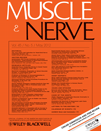Intra- and internerve cross-sectional area variability: New ultrasound measures
Abstract
Introduction: Nerve involvement in immune-related neuropathies is non-homogeneous, and therefore characterization of ultrasound (US) abnormalities is difficult. We developed two measures to quantify US abnormalities in immune-related neuropathies. Methods: Intranerve cross-sectional area (CSA) variability for each nerve was calculated as: maximal CSA/minimal CSA. Internerve CSA variability for each patient was calculated as: maximal intranerve CSA variability/minimal intranerve CSA variability. Six patients underwent US evaluation of the median, ulnar, and fibular nerves, and the abnormalities were scored with our newly developed measures. Results: The new measures were applicable to all nerves and patients. The highest degree of intra- and internerve CSA variability was observed in multifocal motor neuropathy, consistent with the asymmetric characteristics of this neuropathy. Conclusions: The application of intra- and internerve CSA variability measures allows us to quantify the heterogeneity of nerves and nerve segments and identify different US patterns in diverse immune-related neuropathies. Muscle Nerve, 2012




